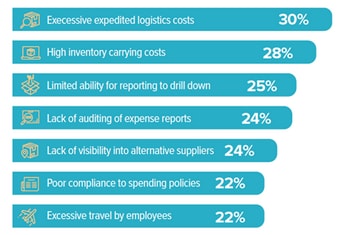Travel and Expense
Next-Gen Spend Management Has Arrived – And Just in Time
How much of your organization’s revenue goes toward spend? For most companies, it's 40% to 45%. That’s a huge part of the revenue pie – and a notoriously difficult slice to monitor and control company-wide. As explored in a 2019 survey on intelligent spend management commissioned by SAP and conducted by IDC – which polled 800+ leaders worldwide across finance, procurement, supply chain and IT functions – spend control issues are diverse and widespread (see the figure).

Figure: Specific spend control issues as noted by business leaders. Source: Mickey North Rizz and Kevin Permenter, “The Future of Spend Management: Approaches, Opportunities and Challenges in a Digital World," IDC white paper sponsored by SAP, November 2019.
Nor do most companies have real-time insights into spending to drive better decisions before it’s too late. Without centralized, real-time spend data and best-in-class controls, how can you:
- Manage financial fundamentals for the business?
- Redirect spend as priorities change and new opportunities emerge?
- Select vendors that will improve product satisfaction, employee safety, and brand reputation?
- Reduce expedited logistics costs and reliance on costly buffer stock?
- Get a consolidated spending view of spend and suppliers?
- Properly audit invoices matched with POs and contracts?
- Address excessive employee travel?
Put simply, you can’t. Consider the need to optimize spend on things like travel, expenses, and procurement. Without actionable, real-time data that considers both present and future conditions, how can you gain visibility into employee travel patterns needed to negotiate optimized rates for frequently used hotels, rail services, or airlines? How can you incentivize budget-conscious spending at just the right time – when employees are making travel decisions?
The key to addressing spend management challenges – whether in travel, expenses, or invoiced spending by employees – is digitalizing spend management processes on a single platform. Digitalization involves shifting away from transactional processing and semiautomated processes, so you can centralize data and manage supplier relationships while also controlling costs and reducing risk.
In fact, 90% of IDC’s survey respondents reported having room to improve how they control spend. Key priorities of such investments include enabling audits across all types of spend, providing transparency across all spend categories, and enforcing compliance with organizational spend policies. In addition, 95% of survey respondents said they were likely to invest in and deploy intelligent spend management platforms in the next two years.
But none of this can be achieved without leadership from IT partnering with finance to deliver intelligent spend management. In a new research paper, “The Future of Spend Management: Approaches, Opportunities and Challenges in a Digital World,” IDC notes: “Intelligent spend management is where the traditional processes of spend management are augmented with artificial intelligence and machine learning algorithms. The added intelligence is essential to maximizing both the cost-saving potential of a unified spend management approach and the agility gains inherent in an intelligent spend management solution.”
These intelligent technologies and solutions are used to:
- Break down barriers between finance, procurement, and the supply chain for a unified view of spending.
- Bring all spend together on a safe, secure infrastructure.
- Give finance, procurement, and supply chain leaders visibility and control of each spend category with tools to orchestrate spend across categories.
According to IDC, intelligent spend management is a hot topic amongst business leaders, with 60% of survey respondents reporting that they are already talking with a technology vendor about an intelligent spend management platform. Want to learn more about how you can transform spend management? Read the full IDC White Paper, “The Future of Spend Management: Approaches, Opportunities and Challenges in a Digital World.”
